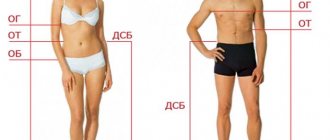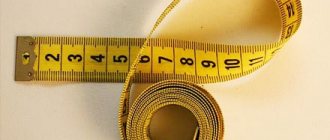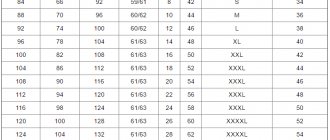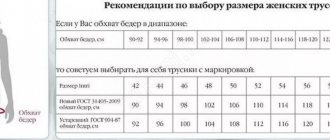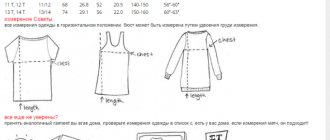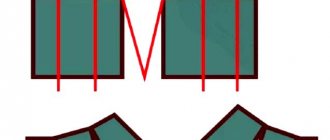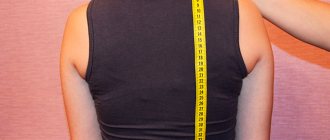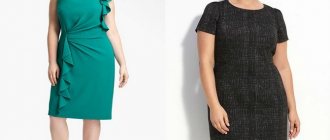This information will help you easily learn how to measure your figure. In special tables you can find your size of outerwear, trousers, skirts and jeans in all generally accepted classifications.
Every woman simply must know the parameters of her figure. When ordering clothes from the Internet or visiting a store, this knowledge will become a real lifesaver. Moreover, taking measurements will not take much time, and while shopping it will help you focus not on the waist circumference or sleeve length, but on the color of the new thing and its design.
Measuring your body parameters is easy
Four simple rules will help you take measurements correctly
- Take measurements in thin clothing that does not distort your figure.
- The centimeter should fit well to the body, but not be too tight or loose.
- To make the measurement easier, you can ask another person for help.
- You need to stand straight and relax as much as possible.
Basic measurements can be as follows:
The waist circumference should be measured at the narrowest part (located between the ilia and lower ribs), the arms should be relaxed and lowered. Measurements are taken horizontally, parallel to the floor. Do not pull in your stomach.
The chest circumference is also measured horizontally and parallel to the floor, the centimeter crosses the most protruding points of the chest, the armpits and then the shoulder blades. The measurement is taken while exhaling.
The circumference of the hips is determined by the most protruding place; if the stomach is at the same level, you need to measure along with it. It is better to take several measurements in a row - the largest value is the correct result.
Sleeve length is measured from the intended shoulder seam to the desired length or wrist along the upper edge of the arm.
Table of measurements for shoulder and waist products
If the figure is close to standard, then even without taking measurements, you can understand the size using a standard size chart and table. But today it is difficult to find a model whose figure does not have some deviations. Also, the parameters shown in the table below are approximate.
There is a simpler measurement method that is based on studying chest girth and simple mathematics. The resulting girth value is divided in half. This indicator will be the size of future shoulder or waist clothing according to domestic standards. For example, if the chest volume is 80, then the size will be 40. The same applies to other measurements with girth. What values are divisible by two are indicated below.
You might be interested in the procedure for calculating and constructing the basis of a basic pattern
Sewing measurements table for women for shoulder and waist items
Table 1. Dresses, skirts, sweaters, etc.
| Waist circumference | Hip girth | Bust | Sleeve length | Russian size | International size | USA | Europe | Italy | England | Japan |
| 58 | 82 | 76 | 58 – 60 | 38 | XXS | 0 | 32 | 36/0 | 4/30 | 3 |
| 62 | 86 | 80 | 59 – 61 | 40 | XS | 2 | 34 | 38/I | 6/32 | 5 |
| 66 | 92 | 84 | 59 – 61 | 42 | S | 4 | 36 | 40/II | 8/34 | 7 |
| 70 | 96 | 88 | 60 – 62 | 44 | M | 6 | 38 | 42/III | 10/36 | 9 |
| 74 | 100 | 92 | 60 – 62 | 46 | M | 8 | 40 | 44/IV | 12/38 | 11 |
| 78 | 104 | 96 | 60 – 62 | 48 | L | 10 | 42 | 46/V | 14/40 | 13 |
| 82 | 108 | 100 | 61 – 63 | 50 | L | 12 | 44 | 48/VI | 16/42 | 15 |
| 86 | 112 | 104 | 61 – 63 | 52 | XL | 14 | 46 | 50/VII | 18/44 | 17 |
| 90 | 116 | 108 | 61 – 63 | 54 | XXL | 16 | 48 | 52/VIII | 20/46 | 19 |
| 94 | 120 | 112 | 61 – 63 | 56 | XXL | 18 | 50 | 54/IX | 22/48 | 21 |
| 98 | 124 | 116 | 62 – 64 | 58 | XXXL | 20 | 52 | 56/X | 24/50 | 23 |
| 100 | 128 | 120 | 62 – 64 | 60 | 4XL | 22 | 54 | 58/XI | 26/52 | 25 |
| 104 | 132 | 124 | 62,5 – 65 | 62 | 4XL | 24 | 56 | 60/XII | 28/54 | 27 |
| 108 | 136 | 128 | 62,5 – 65 | 64 | 4XL | 26 | 58 | 62/XIII | 30/56 | 29 |
| 112 | 140 | 132 | 62,5 – 65 | 66 | 5XL | 28 | 60 | 64/XIV | 32/58 | 31 |
| 116 | 144 | 136 | 62,5 – 65 | 68 | 5XL | 30 | 62 | 66/XV | 34/60 | 33 |
| 120 | 148 | 140 | 62,5 – 65 | 70 | 5XL | 32 | 64 | 68/XVI | 36/62 | 35 |
How to correctly take measurements of a woman's figure
To obtain accurate results, follow simple rules when taking measurements:
Take measurements while wearing tight-fitting clothing or underwear that is intended to be worn under the product. After all, corrective underwear can slim your figure, removing 1-3 cm of volume, while a bra, on the contrary, can add volume.
When taking measurements, stand upright, keeping your back straight, without slouching. Place your arms down and don't bend your legs.
Tie a cord or rope around your waist - this will make it easier to take measurements related to the waist line.
Apply the measuring tape tightly to the body, without pulling, but also without relaxing.
All measurements of a female figure are taken from the right side of the body.
To take the most important measurements that form the balance of the product, it is convenient to use the shoulder pad.
All dimensional characteristics are divided into transverse and longitudinal. A complete list of measurements for clothing design can include up to 70 measurements. Some of them are calculated by subtraction.
To determine half girths, measure the full girth and divide the result by 2.
Some measurements begin to be taken from the seventh cervical vertebra . Finding it is simple: tilt your head downwards, and where the neck meets the torso, feel the most protruding tubercle. This is the seventh cervical vertebra.
We recommend
The name of the measurements and their measurement lines
1. Chest girth (Og) - at the most protruding points of the chest.
2. Center of the chest (CH) - measured between the protruding points of the mammary glands. The tape lies horizontally.
3. Waist circumference (From) - at the narrowest point at the waist.
4. Hip circumference (H) - at the most protruding points of the buttocks.
5. Second hip girth - measured just below the buttocks along the protruding parts of the “breeches” (fat deposits on the outer side of the thigh). If this measurement is larger than the circumference of the hips, then when creating patterns it is used, especially for products with an adjacent silhouette.
6. Hip height (Wb) - measured from the side from the waist line to the hip line.
7. Chest height (Вг) - from the point of transition of the neck to the shoulder (base of the neck) to the most protruding point of the chest.
8. Length to the front waist (FW) - from the base of the neck through the most protruding point of the chest to the waist line.
9. Neck circumference (Osh) - measured at the base of the neck.
10. Height of the shoulder oblique front (Vpkp) - from the point of intersection of the sagittal of the figure with the waist line of the front to the extreme point of the shoulder.
11. Oblique shoulder height (HHH) - along the back from the point of the spine at the waist line to the extreme shoulder point.
12. Length to the waist along the back (Dts1) - from the seventh cervical vertebra to the waist line.
13. Back width (Ws) - measured horizontally through the center of the shoulder blades between the rear corners of the armpits.
14. Length to the waist along the back, taking into account height (Dts2) - from the base of the neck to the waist line.
15. Shoulder length (Ll) - from the base of the neck to the point of articulation of the shoulder with the arm.
16. Product length (Di) - for shoulder products, measure from the seventh cervical vertebra to the desired length.
17. Knee length (Ktk) - from the point at the waist to the middle of the knee.
18. Armhole depth (D) - from the seventh cervical vertebra to the vertical line that runs from the posterior corner of the armpit to the middle of the back. To measure, you can hold a strip of paper 4 centimeters wide under your arm, reaching up to your spine.
19. Armhole width (Armhole) - a strip of paper is held horizontally under the armpit and a marker is used to mark the vertical stripes on both sides of the arm. The length of the resulting segment on paper is the required measurement.
20. Sleeve length (Dr) - along the arm slightly bent at the elbow from the end of the shoulder to the wrist.
21. Shoulder circumference (Op) - measured horizontally along the widest upper part of the arm.
22. Wrist circumference (Oz) - around the base of the hand along the bone.
23. Seat height (S) - measured while sitting on a hard, flat surface, from the back from the waist line to the seat level.
24. Arc through the groin area (Dp.ob) - measured between the legs from the waist line in front to the waist line in the back.
25. Arc of the torso through the groin area (DTp.ob) - from the back from the seventh cervical vertebra to the waist line; from the back waistline through the groin to the front waistline; from the front waistline to the base of the neck. The resulting three values are added together.
26. Front shoulder height (FSH) - from the point of articulation of the shoulder with the arm to the most protruding point of the chest.
27. Girth above the chest (Og1) - horizontally above the base of the chest.
28. Second chest width (W2) - measured through the high points of the chest between the front corners of the armpits. Recorded at half size.
29. Girth under the chest (Og3) - horizontally under the base of the chest.
30. Front length (FB) - from the point at the waist along the protruding part of the abdomen to the floor.
31. Side length (DSL) - from the point at the waist along the protruding part of the hip to the floor.
32. Shoulder width (W) - horizontally between the extreme points of the shoulders.
33. Overall length of the product (Di) - from the back from the seventh cervical vertebra along the spine through the waist line to the desired length.
34. Thigh circumference (Lunch) - at the widest point of the leg, slightly below the subgluteal fold.
35. Leg circumference (He) - measured 10 centimeters above the knee.
36. Knee circumference (OK) - horizontally around the knee.
37. Calf girth (Gi) - horizontally at the widest part of the calf muscle.
38. Ankle circumference (Osh) - horizontally along the thinnest place at the bottom of the leg.
39. Length at the back (Dsz) - from the point at the waist along the protruding part of the buttocks and to the floor.
40. Skirt length (Du) - from the back from the waist line along the most protruding point of the hip to the desired length.
41. Step length (Lsh) - from the groin along the inside of the leg to the floor level, with legs slightly apart.
42. Height (Dt) - distance from the apical point to the floor.
43. First chest width (Shg 1) - measured above the base of the mammary glands between vertical lines drawn up from the front corners of the armpits. The tape should lie horizontally directly above the girth line above the chest. Recorded at half size.
44. Half-chest girth first (PoG1) - measured horizontally through the convex places of the shoulder blades and above the mammary glands.
45. Second half-chest girth (PoG2) - measured horizontally through the convex places of the shoulder blades and along the high points of the chest.
The first and second half-circumferences of the chest are measured strictly one after the other; the position of the measuring tape should only change on the front of the chest. The results are recorded divided in half.
46. Body position (Pc) - measured horizontally from the cervical point to the vertical plane touching the most posteriorly protruding points of the shoulder blades. This is a measure of posture.
47. Waist depth first (Gt1) - measure the horizontal distance from the vertical plane touching the protruding points of the shoulder blades to a ruler applied horizontally to the longitudinal muscles of the back at the level of the waist line.
48. Second waist depth (Gt2) - measure the horizontal distance from the vertical plane touching the buttock points to a ruler applied horizontally to the longitudinal muscles of the back at waist level.
49. Length of the back to the waist, taking into account the protruding shoulder blades (Lts) - measured from the waist line to the cervical point along the spine through a thin plate up to 2 centimeters wide, superimposed on the protruding points of the shoulder blades.
50. Height of the neck point (Vsht) - the distance from the floor to the neck point.
51. Head height (Height) - determined by subtracting the height of the cervical point from height (Dt).
52. Height of the point of the base of the neck (Vtosh) - the distance from the floor to the point of the base of the neck.
53. The height of the shoulder point (Vpt) is the distance from the floor to the shoulder point.
54. The height of the clavicular point (Vkt) is the distance from the floor to the clavicular point.
55. Height of the knee point (Vkt) - the distance from the floor to the knee point.
56. Height of the posterior angle of the axilla (Vzu) - the distance from the floor to the posterior angle of the axilla.
57. The height of the subgluteal fold (HS) is the distance from the floor to the middle of the subgluteal fold.
58. Arc through the highest point of the shoulder joint (AP) - measured vertically from the level of the posterior angle of the axilla through the highest point of the shoulder joint to the level under the anterior angle of the axilla.
59. Vertical diameter of the arm (dvr) - determined by subtracting the height of the posterior angle of the armpit from the height of the shoulder point.
60. Head circumference (Ogol) - measured through the most protruding point of the back of the head and the center of the forehead.
61. Hand girth (Okis) - measured perpendicular to the axis of the hand through the metacarpophalangeal joint of the first finger, which should be 30-35 degrees away from the second.
62. Bent knee circumference (Ox) - measure the leg, bent at the knee at a right angle, along the popliteal fossa through the knee point.
63. Instep circumference (Oc) - through the back most protruding point of the heel and the highest point of the instep. The tape closes at the front.
64. Length of the arm to the elbow (Dr.lok) - the distance from the shoulder to the radial point.
65. Half waist circumference (St) - half the waist circumference measurement.
66. Half-girth of the hips, taking into account the protruding abdomen (Sb) - at the buttock points, horizontally around the body along the protruding abdomen. The resulting value is recorded by dividing by 2.
67. Half-girth of the hips without taking into account the protruding abdomen (Sb1) - along the buttock points horizontally around the body. The resulting value is recorded by dividing by 2.
68. Neck half-girth (Ssh) - a measuring tape with the lower edge is placed above the cervical point; from the side and in front, the tape passes along the base of the neck, touching the clavicular points with the lower edge and closing above the jugular cavity. The result obtained is divided in half.
69. Transverse diameter of the neck (dsh) - between the points of the base of the neck.
70. Shoulder diameter (dп) - measured from the front between the shoulder points.
It is convenient to record the measurements taken in a table, where half and quarter values will then be calculated. An example of such a table is presented below.
| Measure | Meaning | 1/2 measure | 1/4 measure |
| Waist circumference | |||
| Hip girth | |||
| … |
It is very important to analyze the figure: determine the type of posture and body features .
There are three types of posture:
- normal
- stooped
- kinky
A stooped figure by a convex back, a greater tilt of the neck forward and a lesser bend in the waist from the back. The shoulders are also tilted slightly forward.
A curved figure has the opposite: the neck is straighter, the back is straight and there is a large deflection at the waist. The shoulders are pulled back and the chest is more prominent.
The type of posture can be assessed not only visually, but also by the following measurements:
- Front length to waist (Lts);
- Back length to waist (Dtp);
- Half chest circumference 1 (PoG1);
- Half chest circumference 2 (PoG2);
These measurements need to be compared: find the difference in lengths and half-circumferences.
Rdt=Dtp-Dts
Рсг=Сг2-Сг1
Calculating posture:
Os=Rdt-Rsg+2.5cm
We get the result:
- Os=0 - normal posture
- Os with a negative value - stooped posture
- Os with a positive value - kinked posture
Types of posture are always taken into account when creating a basic pattern.
In addition to analyzing the figure, it is also recommended to compare measurements: chest width first (Wg1) and chest width second (Wg2), half chest girth first (Cr1) and half chest girth second (Cr2). Calculations are made using the formula:
Shg2=Shg1+(Cr2-Cr1)
The resulting number should be equal to the second chest width measurement taken from the figure. If this equality does not work out, then it is necessary to check all four measurements, that is, retake them.
Table 2. Outerwear: coats, jackets and raincoats
| Waist circumference | Hip girth | Bust | Sleeve length | Russian size | International size | USA | Europe | Italy | England | Japan |
| 58 | 82 | 76 | 58/60 | 38 | XXS | 0 | 32 | 36 | 30 | 3 |
| 62 | 86 | 80 | 59/61 | 40 | XS | 2 | 34 | 38 | 32 | 5 |
| 66 | 92 | 84 | 59/61 | 42 | S | 4 | 36 | 40 | 34 | 7 |
| 70 | 96 | 88 | 60/62 | 44 | M | 6 | 38 | 42 | 36 | 36 |
| 74 | 100 | 92 | 60/62 | 46 | M | 8 | 40 | 44 | 38 | 38 |
| 78 | 104 | 96 | 60/62 | 48 | L | 10 | 42 | 46 | 40 | 40 |
| 82 | 108 | 100 | 61/63 | 50 | L | 12 | 44 | 48 | 42 | 42 |
| 86 | 112 | 104 | 61/63 | 52 | XL | 14 | 46 | 50 | 44 | 44 |
Table 3. Pants, trousers and skirts
| Waist circumference | Hip girth | Russian size | International size | USA | Europe | Italy | England | Japan |
| 58 | 82 | 38 | XXS | 0 | 32 | 36/0 | 4/30 | 3 |
| 62 | 86 | 40 | XS | 2 | 34 | 38/I | 6/32 | 5 |
| 66 | 92 | 42 | S | 4 | 36 | 40/II | 8/34 | 7 |
| 70 | 96 | 44 | M | 6 | 38 | 42/III | 10/36 | 9 |
| 74 | 100 | 46 | M | 8 | 40 | 44/IV | 12/38 | 11 |
| 78 | 104 | 48 | L | 10 | 42 | 46/V | 14/40 | 13 |
| 82 | 108 | 50 | L | 12 | 44 | 48/VI | 16/42 | 15 |
| 86 | 112 | 52 | XL | 14 | 46 | 50/VII | 18/44 | 17 |
| 90 | 116 | 54 | XXL | 16 | 48 | 52/VIII | 20/46 | 19 |
| 94 | 120 | 56 | XXL | 18 | 50 | 54/IX | 22/48 | 21 |
| 98 | 124 | 58 | XXXL | 20 | 52 | 56/X | 24/50 | 23 |
| 100 | 128 | 60 | 4XL | 22 | 54 | 58/XI | 26/52 | 25 |
| 104 | 132 | 62 | 4XL | 24 | 56 | 60/XII | 28/54 | 27 |
| 108 | 136 | 64 | 4XL | 26 | 58 | 62/XIII | 30/56 | 29 |
| 112 | 140 | 66 | 5XL | 28 | 60 | 64/XIV | 32/58 | 31 |
| 116 | 144 | 68 | 5XL | 30 | 62 | 66/XV | 34/60 | 33 |
| 120 | 148 | 70 | 5XL | 32 | 64 | 68/XVI | 36/62 | 35 |
Table 4. Jeans
| Waist circumference | Hip circumference (cm) | Waist (inches) | Russian size | International size | USA |
| 58 | 82 | 24 | 38 | XXS | 0 |
| 62 | 86 | 25 | 40 | XS | 0-2 |
| 66 | 92 | 26 | 42 | S | 2 |
| 66 – 70 | 92 – 96 | 27 | 42 – 44 | S/M | 2 – 4 |
| 70 | 96 | 28 | 44 | M | 4 |
| 68 – 74 | 96 – 100 | 29 | 44 – 46 | M | 4 – 6 |
| 74 | 100 | 30 | 46 | M | 6 |
| 74 – 78 | 100 – 104 | 31 | 46 – 48 | M/L | 6 – 8 |
| 78 | 104 | 32 | 48 | L | 8 |
| 78 – 82 | 104 – 108 | 33 | 48 – 50 | L | 8 – 10 |
| 82 | 108 | 34 | 50 | L | 10 |
| 82 – 86 | 108 – 112 | 35 | 50 – 52 | L/XL | 10 – 12 |
| 86 | 112 | 36 | 52 | XL | 12 |
| 90 | 116 | 38 | 54 | XXL | 14 |
| 94 | 120 | 39 | 56 | XXL | 16 |
| 98 | 124 | 40 | 58 | XXXL | 18 |
| 100 | 128 | 41 | 60 | 4XL | 20 |
| 104 | 132 | 42 | 62 | 4XL | 22 |
| 108 | 136 | 43 | 64 | 4XL | 24 |
| 112 | 140 | 44 | 66 | 5XL | 24 |
Have you decided to sew yourself? Check out GOST!
Dressing with taste, carefully selecting every element of the wardrobe, being a role model, shocking, attracting admiring glances - all fashionistas dream . But among a large number of things, sometimes even exclusive ones, it is very, very difficult to find “yours.” Especially if you have a non-standard figure. In this case, the ability to sew yourself will be very useful.
And in other cases it won’t hurt - it’s convenient, and it can also become a good hobby, inspire and delight.
If you feel the strength and desire to start sewing at an amateur level, then your reference books should certainly be not only various tutorials on cutting and sewing, but also state standards.
What is it for? GOST, as a technical passport for a washing machine. To wash this or that item, you can run any program, relying only on advice on the Internet, but you need to be prepared for the fact that the result may be disappointing: the item will not wash or the equipment will fail.
To prevent this from happening, it is better to use proven instructions prepared by experts in their field.
And even though after 2011, compliance with GOSTs in the Russian Federation became optional (now they are in the nature of recommendations), there is still a lot of useful information there.
The second important block is the parameters that determine the height and length of the product and individual parts
The most recognizable of these measurements is the Overall length of the product (Di). To find out it correctly, you need to determine where the bottom of the future model will be. Place the beginning of the tailor's meter at the place where the neck begins, from the back. Usually this place is considered to be the 7th vertebra of the neck. Fix the tape along the entire spine until it intersects with the lace, indicating the location of the waist, and then lower it down to the planned bottom of the product. Since we are talking about how to take measurements for shoulder items - dresses or blouses - we will next consider a number of relevant indicators.
• The abbreviation DSB or DST refers to the length of the back to the waist. It is recommended to take measurements from the 7th cervical vertebra, and end at the intersection with the waist, while it is important to ensure that the tailor's meter passes strictly at the line of the spine. • The abbreviations Dp, Dts, Dtp refer to the length of the front to the waist / the length of the shelf from the neck or collar. The measurement is taken from the transition area of the neck to the shoulder, then the tailor's meter goes down to the highest point of the chest, and then drops to the waist. • Shoulder length (Lp). The measurement should be taken from the base of the neck at the transition to the shoulder, and completed at the beginning of the arm. • DR is the Sleeve Length. The measurement is taken from the starting point of the hand. It is important to guide the tailor's meter along the outside of the hand, towards the little finger. Removal is completed at wrist level. Important! The arm should be slightly bent at the elbow, in a natural position. If it is completely straight and down, complete the removal at the height of your thumb. To measure Dr for a ¾ sleeve, you must complete the measurement strictly at elbow level. • Vg - this is how tailors write Bust Height. Initiate the removal of the parameter at the point of the base of the neck at the transition to the shoulder, and complete it at the highest point of the mammary glands. • The abbreviations Vp or Vpp refer to the height of the front shoulder. The measurement starts from the starting point of the arm and ends at the highest point of the chest. • Armhole depth (Gp). To measure, you will need a paper tape approximately 3 cm wide. It needs to be passed under the arms and secured under the armpits (just ask the client to hold it under the armpits or do it yourself - if you are taking measurements for yourself). Then, with the assistance of an assistant, take measurements from the 7th cervical vertebra to the beginning of the tape (in the center area). • The height of the back shoulder is oblique (Vpk). You need to initiate the measurement at the point where the arm begins, and end in the middle of the back at the intersection with the lace marking the waist. • Hips height (Wb). This data is measured as follows: it is important to place the tailor's meter on the side, taking the distance from the waist to the hips as information. • Seat height (Sun). Before starting measurements, sit down on a hard horizontal surface. With the assistance of an assistant, this indicator is measured from behind, from the lace showing the waist to the seat itself (the contact of the legs with the surface). Special measurements (Vprz, Vpkp) are determined if necessary.
